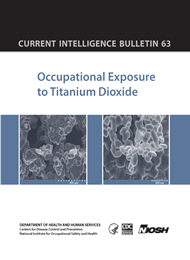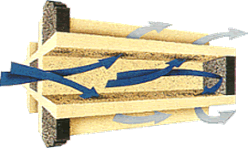Categories: Chemicals, Nanotechnology, Respiratory health
July 26th, 2011 3:00 pm ET -
Vladimir Murashov, PhD, Charles L Geraci, PhD, and David Weissman, MD
A reminder of the need to protect workers from hazardous dust
On June 24, 2011 the Indian Express, an on-line Indian news outlet, published an article reporting a “new” occupational lung disease and implicating a polyacrylate powder, which “seemed to be at the nano-level.”
The article is based on an investigation published by the Peoples Training and Research Center, a voluntary organization raising awareness and providing training on occupational safety and health. It reports a cluster of five cases of workers with severe pleural and pulmonary disease, which developed within 10–12 months of working at a factory that manufactures and processes polyacrylate and other polymers for use in pharmaceuticals. It is not entirely clear from the report, but it appears that two workers had interstitial lung disease with pneumothorax; one worker had interstitial lung disease associated with severe restrictive impairment; one worker had at least one pneumothorax; and one worker died after developing a symptom complex of fatigue, anorexia, and breathlessness, but no additional medical information was available.
 4 Comments -
Read more
4 Comments -
Read more

Categories: Chemicals, Nanotechnology
May 9th, 2011 2:45 pm ET -
Vladimir Murashov, PhD
 A recently released NIOSH guidance document (NIOSH, 2011) on handling titanium dioxide (TiO2) powders in the workplace generated a high level of interest as it put forward an innovative approach that might have implications beyond TiO2. Specifically it may be the first document (originally released for external review as a draft in 2005) to recommend separate occupational exposure limits for the same material based on particle size. This document signifies increasing attention to evaluating and mitigating risks of emerging hazards in the workplace before adverse health effects occur in workers and could proactively be used for how other poorly soluble, low toxicity (PSLT) particles are controlled in the workplace.
A recently released NIOSH guidance document (NIOSH, 2011) on handling titanium dioxide (TiO2) powders in the workplace generated a high level of interest as it put forward an innovative approach that might have implications beyond TiO2. Specifically it may be the first document (originally released for external review as a draft in 2005) to recommend separate occupational exposure limits for the same material based on particle size. This document signifies increasing attention to evaluating and mitigating risks of emerging hazards in the workplace before adverse health effects occur in workers and could proactively be used for how other poorly soluble, low toxicity (PSLT) particles are controlled in the workplace.
What is the basis for this document?
Distinct exposure limits for distinct size fractions. NIOSH recommendations for TiO2, an insoluble white powder, used extensively in many commercial products, including paint, cosmetics, plastics, paper, and food, as an anticaking or whitening agent, go back to 1988 when it classified respirable dust of this material as a potential occupational carcinogen (NIOSH, 2002).
 8 Comments -
Read more
8 Comments -
Read more

Categories: Chemicals, Exposure, Hearing loss
May 18th, 2009 2:21 pm ET -
Chucri A. Kardous, MS, PE
Solutions for Preventing Lead Poisoning and Hearing Loss at Indoor Firing Ranges
 If you work or train regularly at indoor firing ranges, you could be exposed to hazardous levels of lead and noise. An estimated 16,000–18,000 indoor firing ranges operate in the United States. Some do not have sufficient environmental and occupational health controls in place to effectively protect the health of shooters and firing range personnel from exposure to lead (from lead bullets and cartridge primers), noise, and other contaminants. Those at risk include thousands of employees at indoor firing ranges, more than a million Federal, State, and local law officers who are required to train regularly at these facilities, and 20 million active target shooters.
If you work or train regularly at indoor firing ranges, you could be exposed to hazardous levels of lead and noise. An estimated 16,000–18,000 indoor firing ranges operate in the United States. Some do not have sufficient environmental and occupational health controls in place to effectively protect the health of shooters and firing range personnel from exposure to lead (from lead bullets and cartridge primers), noise, and other contaminants. Those at risk include thousands of employees at indoor firing ranges, more than a million Federal, State, and local law officers who are required to train regularly at these facilities, and 20 million active target shooters.
 47 Comments -
Read more
47 Comments -
Read more

Categories: Chemicals, Mining
February 3rd, 2009 7:50 am ET -
Administrator

Figure 1: Schematic of flow through diesel particulate filter
In response to new exposure standards to lower miners’ exposure to diesel particulate matter (DPM), the National Institute for Occupational Safety and Health (NIOSH) and others have conducted research into control technologies to reduce DPM emissions. The mining industry—and specifically dieselized mines—also continue to work toward finding feasible controls to implement in their mines. Although emissions of and exposure to DPM can sometimes be controlled through the use of newer diesel engines, better engine maintenance, use of alternative fuels, or ventilation upgrades, some mines may need to use diesel particulate filters. However, this has created concern about potential exposure to nitrogen dioxide (NO2) resulting from their use.
 14 Comments -
Read more
14 Comments -
Read more





